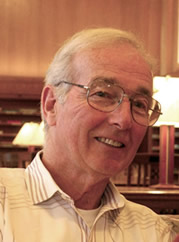
Stephen J. Burns
Professor Emeritus, Department of Mechanical Engineering
Professor Emeritus, Materials Science
PhD, Cornell University, 1967
- Office Location
- 212 Hopeman
- Telephone
- (585) 275-4082
- Fax
- (585) 256-2509
- Web Address
- Website
Research Overview
Fracture Mechanics Applied to Grinding, Polishing, Adhesion and Slitting
Microscopic deformation within a material determines if the solid is brittle or ductile on a macroscopic level. Crack tip shielding for the brittle-to-ductile transition on a microlevel was started at Rochester and is still studied as there is little understanding of this transition in mechanical behavior. Microstructural fracture mechanics is applied to ceramics, polymers, glasses and metals to achieve high fracture toughness. Adhesion mechanics for AFMs, nanoindenters, and macroscopic systems are analyzed for stability. Cutting and slitting mechanics are generally unstable and always give rough surfaces. Controlling cutting stability is a technological challenge for which some progress has been made.
Deformation Kinetics
The constitutive relationship between stress, temperature and strain-rate is called kinetics. Reaction kinetics near a glass transition temperature, Tg involve simultaneous deformation events on an atomic scale; these double events in turn control deformation. In materials that have amorphous or glassy structures, plastic flow and dimensional stability are achieved via non-newtonian kinetics. Kinetics near Tg, are investigated and measured in polymer films. Deformation kinetics are also used to study slow crack propagation.
Thermodynamic Energy Balances in Linear Systems
The assumption that a material is linear in stress vs. strain is widely used in elastic analysis; linear dielectric materials are also generally assumed in electrostatic and electrodynamic systems. These relations are generally isothermal and the elastic constants are temperature dependent. Similarly, the dielectric constants are also dependent on temperature. It has been shown that all isothermal linear materials have a higher order term if the processes follow adiabaticic equations of state. The adiabatic term comes from the temperature dependence of the linear relationship. In the case of a linear capacitor filled with water, the heat term is 40% larger than the electric field energy in the capacitor.
Representative Publications
- Thermodynamics of the Superconducting Phase Transformation in High Tc Ceramics with Magnetoelectric Effects, Journal of Materials Research, Vol.4, p.33, 1989 and Vol.4, p.458, 1989.
- Anisotropic Thermal Conductivity of Rare Earth-Transition Metal Thin Films (with L.J. Shaw-Klein, T.K. Hatwar, S.D. Jacobs and J.C. Lambropoulos), Journal of Materials Research, Vol.7, p.329, 1992.
- A Shear Transformation in a-b Plane of YBaCuO from the Superconductivity Onset, Physica C, Vol.199, p.84, 1992.
- The Crytallization Behavior of Gallstones Grown from Cholesterol (with S. Kumar), Journal of Materials Science: Materials in Medicine, Vol.4, p.460, 1993.
- A Gruneisen Relation on Constant Pressure Lines (with the students in my graduate class: Thermodynamics of Solids, 1991), Journal of the American Ceramic Society, Vol.75, p.3341, 1992.
- A New Model for Deformation Kinetics of Polyethylene Terephthalate Films (with H-C. Chiu, M.D. Ficella and R.C. Benson), Journal of Macro-molecular Science-Physics, Vol.B33, p.87, 1994.
- Growth Kinetics, Phase Transition and Cracking in Cholesterol Gallstones (with S. Kumar and T.N. Blanton), Journal of Materials Research, Vol.10, p.216, 1995.
- Stresses and Cracks in Spherulites from Transformation Strains, Scripta Materialia, Vol.35, p.925, 1996.
- Non-linear Hertzian Indentation Fracture Mechanics (with K.Y. Chia), Journal of the American Ceramic Society, Vol.78, p.2321, 1995 and Vol.78, p.2328, 1995.
- Mechanics of Cutting and Slitting Webs, Experimental Mechanics, 38, 103 (1998), (with R. Meehan).
- The Role of Blade Sharpness in Cutting Instabilities of Polyethylene Terephthalate, J. of Materials Science Letters, 18, 93 (1999), (with R.R. Meehan, J. Kumar, M. Earl and E. Svenson).
- Dependence of birefringence and residual stress near laser-induced cracks in fused silica on laser fluence and on laser-pulse number, Applied Optics 37, 7772 (1998), (with F. Dahmani, A.W. Schmid and J.C. Lambropoulos).
- Arresting ultraviolet-laser damage in fused silica, Optics Letters, 24, 516 (1999), (with F. Dahmani, A.W. Schmid, J.C. Lambropoulos and S. Papernov).
- Fracture of fused silica with 351-nm-laser-generated surface cracks, Journal of Materials Research, 14, 597 (1999), (with F. Dahmani, J.C. Lambropoulos, A.W. Schmid and S. Papernov).
- Strain Based Formulas for Stresses in Profiled Center-Wound Rolls, Journal of the Technical Association of Pulp and Paper Industry, TAPPI, 82, 159 (1999), (with R.R. Meehan and J.C. Lambropoulos).
- Lifetime prediction of laser-precracked fused silica subjected to subsequent laser pulses, Journal of Materials Research, 15, 1182-1189 (2000), (with F. Dahmani, A.W. Schmid and J.C. Lambropoulos and S. Papernov).
- Crack arrest and stress dependence of laser-induced surface damage in fused-silica and borosilicate glass, Applied Optics, 38, 6892 (1999), (with F. Dahmani, A.W. Schmid and J.C. Lambropoulos).
- Surface features and residual strains in AlON Grinding, in Optical Manufacturing and Testing IV, ed. H. P. Stahl, SPIE Proc., Vol. 4451, pp. 165-173 (2001), (with P. D. Funkenbusch, S. M. Gracewski, J. C. Lambropoulos and J. Ruckman).
- Comparison of Stresses in Center-Wound Rolls from Linear Elastic Models, Journal of Applied Mechanics, 70, 606 (2003), (with W. R. Debesis).
- Energy Balances Applied to Electrowetted Systems, Materials Science and Engineering A, 409, 172-178 (2005).
- Modeling Cutting: Plastic Deformation of Polymer Samples Indented with a Wedge, in ASME, Journal of Manufacturing Science and Engineering, 129, 477-484, (2007). (with Richard Meehan).
- Contact Mechanics Models and Algorithms for Dome Polishing with UltraForm Finishing, SPIE, Defense and Security, Vol. 6545, Window and Dome Technologies and Materials, 65450R, pp. 27-35 (2007), (with C. Bouvier and S. Gracewski).
Research Interests
- Fracture Mechanics Applied to Grinding
- Polishing, Adhesion and Slitting
- Deformation Kinetics
- Thermodynamic Energy Balances in Linear Systems
